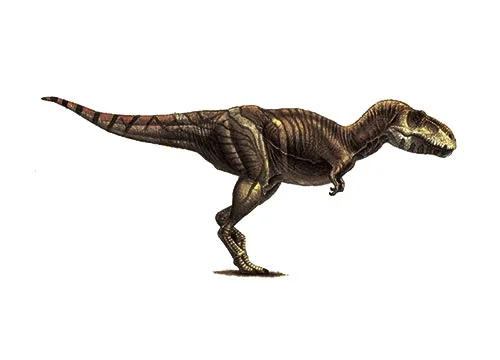Tarbosaurus (Terrifying lizard)

Tar-bo-sore-us
Evgeny Maleev - 1955
Carnivore
Estimated 10-12 meters long
Large Theropod
T. bataar (type)
Mongolia
Late Cretaceous, 70-65 million years ago
Tarbosaurus Facts
Tarbosaurus, also known as the “terrifying lizard,” is a genus of theropod dinosaur that lived during the Late Cretaceous period, around 70-65 million years ago. It was a close relative of the more famous Tyrannosaurus rex, and its fossils have been found in what is now modern-day Mongolia and China.
Tarbosaurus was a large predator, measuring around 33-39 feet (10-12 meters) in length and weighing around 4-6 tons. It had a massive, powerful head with a long, wide jaw lined with dozens of sharp, serrated teeth. Its forelimbs were small and had only two fingers, while its hindlimbs were large and muscular, allowing it to run at high speeds to catch prey.
The fossils of Tarbosaurus have provided important insights into the behavior and biology of large theropod dinosaurs. For example, studies of its teeth have shown that Tarbosaurus was a specialist predator, feeding mainly on large herbivorous dinosaurs like hadrosaurs and ceratopsians. Additionally, the discovery of Tarbosaurus nests and eggs has shed light on its reproductive behavior, showing that it likely laid its eggs in a circular nest and may have provided parental care for its offspring.
The fossils of Tarbosaurus have also helped scientists to better understand the evolution and distribution of tyrannosaurid dinosaurs. In particular, Tarbosaurus is one of the most well-known tyrannosaurids from Asia, and its fossils have provided evidence of a distinct tyrannosaurid fauna in this region during the Late Cretaceous period.
Despite its fearsome name, Tarbosaurus was an important predator in its ecosystem and played a crucial role in maintaining the balance of its prehistoric environment. Its fossils continue to provide valuable insights into the behavior, biology, and evolution of large theropod dinosaurs, and it remains a fascinating subject of study for paleontologists and dinosaur enthusiasts alike.



